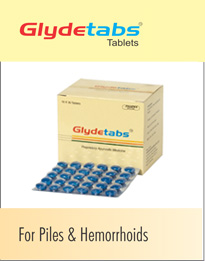Products

Glydetabs - Tablets
Therapeutic Category : Anti-haemorrhoidal
Therapeutic Category : Anti-haemorrhoidal
Actions
The botanical drugs in Glydetabs tablets and Glyde cream synergize to normalize the damaged haemorrhoidal pathology by:
- Scavenging damaging free radicals
- Reducing pain & inflammation
- Enhancing wound healing and
- Stimulating fibro-muscular repair of the fibro-muscular supporting tissue in the mucosa above the anal cushions AND at the same time preventing further deterioration by:
- Aiding stool formation
- Softening the stools and
- Easing faecal evacuation
Indications
- Piles (Arsa)
- Fistula-in-ano (Bhagandara)
- Fissure-in-ano (Parikarta)
- Bleeding Piles (Raktarsa)
- Dry Piles (Suskrasa)



